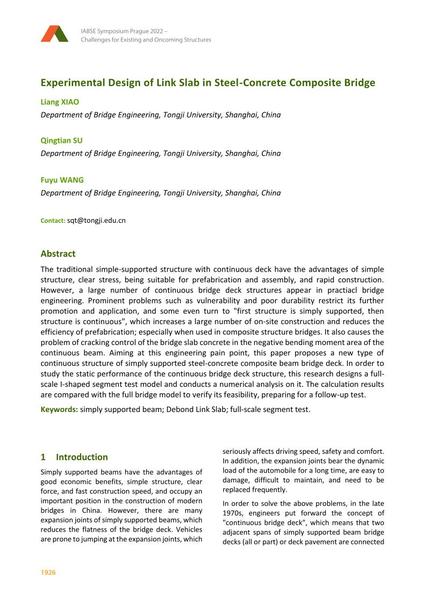Experimental Design of Link Slab in Steel-Concrete Composite Bridge

|
|
|||||||||||
Bibliografische Angaben
| Autor(en): |
Liang Xiao
(Department of Bridge Engineering, Tongji University, Shanghai, China)
Qingtian Su (Department of Bridge Engineering, Tongji University, Shanghai, China) Fuyu Wang (Department of Bridge Engineering, Tongji University, Shanghai, China) |
||||
|---|---|---|---|---|---|
| Medium: | Tagungsbeitrag | ||||
| Sprache(n): | Englisch | ||||
| Tagung: | IABSE Symposium: Challenges for Existing and Oncoming Structures, Prague, Czech Republic, 25-27 May 2022 | ||||
| Veröffentlicht in: | IABSE Symposium Prague 2022 | ||||
|
|||||
| Seite(n): | 1926-1934 | ||||
| Anzahl der Seiten (im PDF): | 9 | ||||
| DOI: | 10.2749/prague.2022.1926 | ||||
| Abstrakt: |
The traditional simple-supported structure with continuous deck have the advantages of simple structure, clear stress, being suitable for prefabrication and assembly, and rapid construction. However, a large number of continuous bridge deck structures appear in practiacl bridge engineering. Prominent problems such as vulnerability and poor durability restrict its further promotion and application, and some even turn to "first structure is simply supported, then structure is continuous", which increases a large number of on-site construction and reduces the efficiency of prefabrication; especially when used in composite structure bridges. It also causes the problem of cracking control of the bridge slab concrete in the negative bending moment area of the continuous beam. Aiming at this engineering pain point, this paper proposes a new type of continuous structure of simply supported steel-concrete composite beam bridge deck. In order to study the static performance of the continuous bridge deck structure, this research designs a full- scale I-shaped segment test model and conducts a numerical analysis on it. The calculation results are compared with the full bridge model to verify its feasibility, preparing for a follow-up test. |
||||
| Copyright: | © 2022 International Association for Bridge and Structural Engineering (IABSE) | ||||
| Lizenz: | Die Urheberrechte (Copyright) für dieses Werk sind rechtlich geschützt. Es darf nicht ohne die Zustimmung des Autors/der Autorin oder Rechteinhabers/-in weiter benutzt werden. |
||||

